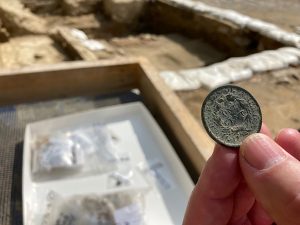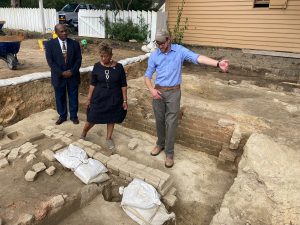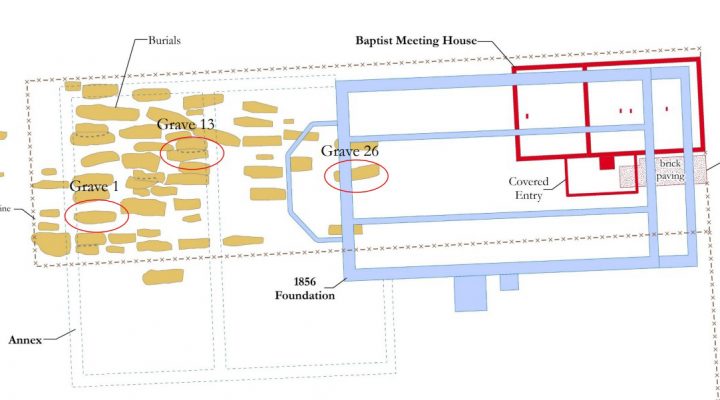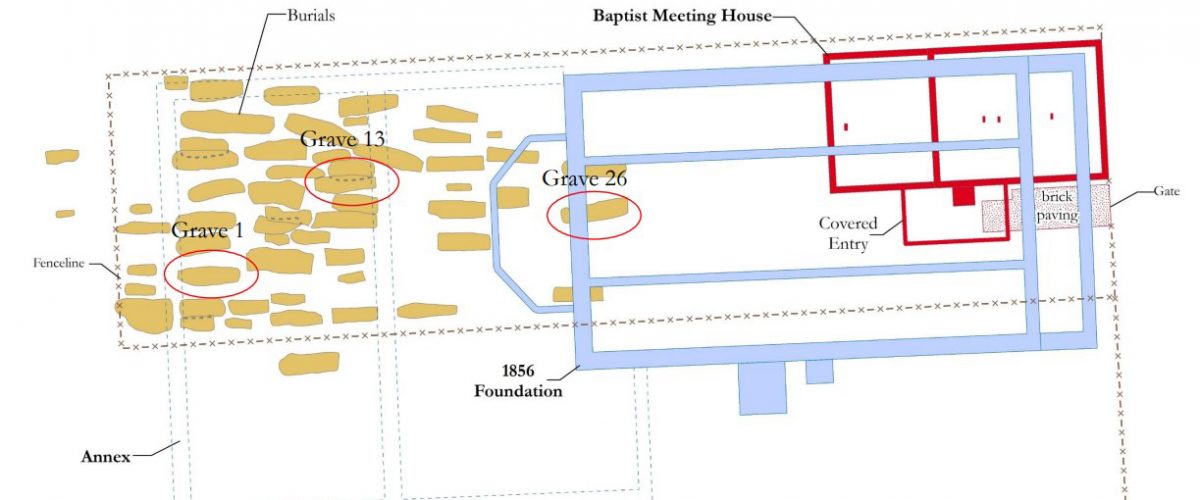Archaeologists and scientists have confirmed the remains of three individuals buried in the Historical Area of Colonial Williamsburg are early 19th-century ancestors of First Baptist Church, one of the oldest Black congregations in the United States.
DNA and bone analysis coupled with archaeological artifacts helped experts confirm the burials were connected with the church’s first permanent structure in Williamsburg, according to Jack Gary, director of archaeology for the Colonial Williamsburg Foundation.
“That has always seemed like the most logical explanation for these burials, but without definitive proof we couldn’t rule out the possibility that the burials were associated with another group or from a different time period,” he said. “Now we can say for sure that these are people connected to the earliest years of First Baptist Church. Now the congregation can decide how to move forward.”
About 100 community and church members met in Williamsburg’s Stryker Center April 6 to hear presentations on the research from experts with Colonial Williamsburg, the College of William and Mary, and the University of Connecticut.

An aerial view of the excavation of the site where the original building of First Baptist Church of Williamsburg was situated. The cemetery site is out of the frame toward the bottom of this image. (Colonial Williamsburg Foundation)
“This is what we were praying we would hear,” said Connie Matthews Harshaw, a church member and president of the Let Freedom Ring Foundation. “To know for certain that these are our people and that this was our congregation is such a powerful step forward in the ongoing work of reconstructing our history and telling a more complete story.”
Of the three sets of remains excavated last summer at the church’s original site on Nassau Street, only one was preserved enough to yield a DNA sample, said Raquel Fleskes, a national Science Foundation post-doctoral fellow at the University of Connecticut. She conducted the DNA testing that confirmed the remains were those of a male of African descent. She added that the date of the burials made them too old to determine biological kinship with contemporary members of the church.
Scientists at the Institute for Historical Biology and at William and Mary, meanwhile, were able to determine that the other remains excavated were those of men between the ages of 35 and 45 “and therefore likely among the generation that first worshipped at the original site. The male whose remains yielded the DNA sample was 16 to 18 years of age “and had experienced early childhood stressors,” Colonial Williamsburg officials said.

Jack Gary, Colonial Williamsburg’s director of archaeology, holds a one-cent coin from 1817 found at the site of the original building of First Baptist Church of Williamsburg, Va. The coin helped archaeologists confirm that a recently unearthed brick-and-mortar foundation belonged to one of the oldest Black churches in the United States. (AP Photo/Ben Finley)
Archaeological evidence included the tip of a straight pin, buttons from one of the burials, coffin nails and fence posts outlining a cemetery. When compared to the placement of other grave sites, the evidence suggested the burials occurred during the first half of the 19th century, Gary added.
“All three lines of evidence — DNA results, osteological analysis, and archaeological findings — provide support and create a compelling argument that these are indeed the ancestors of the First Baptist community,” he reported.
First Baptist Church was established in 1776 by enslaved and free Black worshipers. The excavation and study of the three burials is part of a larger excavation of the church’s first site location and is led by Colonial Williamsburg and the Let Freedom Ring Foundation in collaboration with William and Mary and other participants.
“This project will guide how this site is interpreted, commemorated and ultimately recreated so present and future generations may learn about this nationally significant church,” the Colonial Williamsburg Foundation explained.
The research began in March 2022 when members of First Baptist Church voted to permit excavations of the three graves to determine if the remains were connected to the congregation. Excavation of the three graves began on July 18, 2022, and concluded in early September 2022.
Last fall, Baptist News Global sponsored an educational event at Colonial Williamsburg on the hidden history of racism in early America. Participants stood just a few feet away from the original cemetery and the excavation work as they heard a presentation from an archaeologist working on the dig.

Reginald F. Davis, pastor of First Baptist Church, Connie Matthews Harshaw, a member of First Baptist, and Jack Gary, Colonial Williamsburg’s director of archaeology, stand at the brick-and-mortar foundation of one the oldest Black churches in the U.S. on Oct. 6, 2021, in Williamsburg, Va. Experts announced Thursday, April 6, 2023, that three men whose graves were found at the site were members of the church in the early 19th Century. (AP Photo/Ben Finley, File)
The cemetery sits beside the site of the 1818 wood-frame building of First Baptist Church. That first building — known as the “Black Baptist meeting house” — was destroyed by a tornado in 1834, then replaced with a second, much larger, facility in 1856. That building stood 100 years, until the Colonial Williamsburg Foundation bought the property and helped the congregation build an even larger building nearby but outside the Colonial district. The foundation razed the 1856 building and replaced it with a parking lot.
Only recently, the Colonial Williamsburg Foundation tore up the asphalt and began to excavate the entire site, which is open to view by visitors. Archaeologists quickly discovered 40 burial plots on the site and believe there are many more.
Some current First Baptist members chart their family heritage back to the early days of the church and submitted to genetic testing in hopes of learning some of the people buried in the cemetery are their distant relatives.
If all goes as planned, a replica of the first church building will be constructed on the original foundation by 2026, when the cemetery area will be established as a commemorative space.
Related articles:
Voices of freedom continue to speak from Colonial Williamsburg church
How we’re learning to see and hear the Black experience at Colonial Williamsburg | Analysis by Ella Wall Prichard


